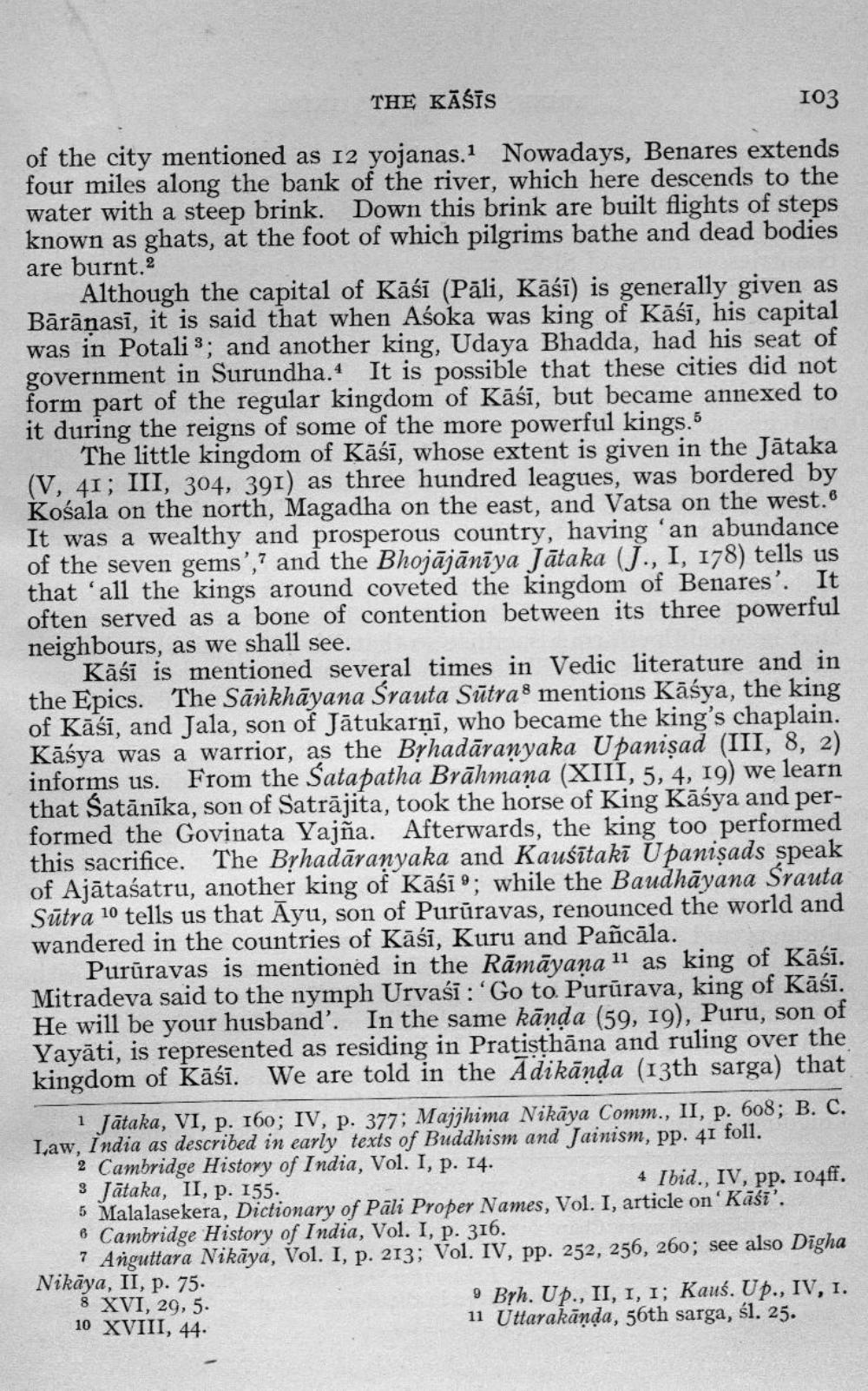________________
THE KĀŠĪS
103 of the city mentioned as 12 yojanas. Nowadays, Benares extends four miles along the bank of the river, which here descends to the water with a steep brink. Down this brink are built flights of steps known as ghats, at the foot of which pilgrims bathe and dead bodies are burnt.2
Although the capital of Kāśī (Pāli, Kāśi) is generally given as Bārāṇasī, it is said that when Asoka was king of Kāśi, his capital was in Potali 3; and another king, Udaya Bhadda, had his seat of government in Surundha. It is possible that these cities did not form part of the regular kingdom of Kāśī, but became annexed to it during the reigns of some of the more powerful kings.
The little kingdom of Kāśi, whose extent is given in the Jātaka (V, 41; III, 304, 391) as three hundred leagues, was bordered by Kośala on the north, Magadha on the east, and Vatsa on the west. It was a wealthy and prosperous country, having 'an abundance of the seven gems',' and the Bhojājānīya Jātaka (J., 1, 178) tells us that 'all the kings around coveted the kingdom of Benares'. It often served as a bone of contention between its three powerful neighbours, as we shall see.
Kāśi is mentioned several times in Vedic literature and in the Epics. The Sānkhāyana Srauta Sūtra8 mentions Kāśya, the king of Kāśī, and Jala, son of Jātukarņi, who became the king's chaplain. Kāśya was a warrior, as the Byhadāranyaka Upanişad (III, 8, 2) informs us. From the Satapatha Brāhmaṇa (XIII, 5, 4, 19) we learn that Satānīka, son of Satrājita, took the horse of King Kāśya and performed the Govinata Yajña. Afterwards, the king too performed this sacrifice. The Brhadāranyaka and Kauśīta kī Upanişads speak of Ajātasatru, another king of Kāśi 9; while the Baudhāyana Srauta Sūtra 10 tells us that Āyu, son of Purūravas, renounced the world and wandered in the countries of Kāśi, Kuru and Pañcāla.
Purūravas is mentioned in the Rāmāyana 11 as king of Kāśi. Mitradeva said to the nymph Urvasi : 'Go to. Purūrava, king of Kāśi. He will be your husband'. In the same kānda (59, 19), Puru, son of Yayāti, is represented as residing in Pratisthāna and ruling over the kingdom of Kāśi. We are told in the Adikānda (13th sarga) that
1 Jataka, VÍ, p. 160; IV, p. 377; Majjhima Nikāya Co ., II, p. 608; B. C. Law, India as described in early texts of Buddhism and Jainism, pp. 41 foll.
2 Cambridge History of India, Vol. I, p. 14. 3 Jataka, II, p. 155.
4 Ibid., IV, pp. 104ff. 5 Malalasekera, Dictionary of Pāli Proper Names, Vol. I, article on Kāśi'. 6 Cambridge History of India, Vol. I, p. 316.
? Anguttara Nikāya, Vol. I, p. 213; Vol. IV, pp. 252, 256, 260; see also Dīgha Nikaya, II, p. 75. 8 XVI, 29, 5.
9 Byh. Up., II, 1, 1; Kauś. Up., IV, 1. 10 XVIII, 44.
11 Uttarakānda, 56th sarga, śl. 25.




